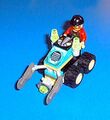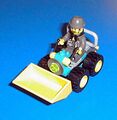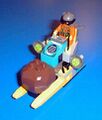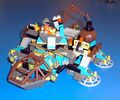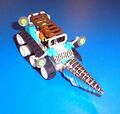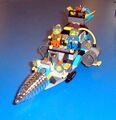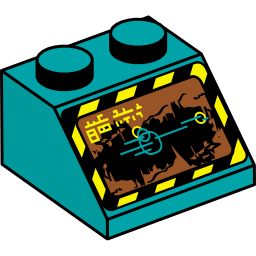LEGO Rock Raiders: Difference between revisions
(Adding Magma Mites info) |
(→Legacy) |
||
| Line 131: | Line 131: | ||
Many speculate the Raiders are still Rocking to this day. | Many speculate the Raiders are still Rocking to this day. | ||
A second wave of Underground sets named "Magma Mites" was planned to follow Rock Raiders. The theme was pitched by the Boston branch of LEGO Futura, but was rejected due to the LEGO Group's financial struggles at the time. It would have taken place in molten caverns and featured heavy mining equipment with electronic elements, which could have been controlled with tie-in computer software. The titular Magma Mites were planned to have flame-shaped heads (following previous unreleased | A second wave of Underground sets named "Magma Mites" was planned to follow Rock Raiders. The theme was pitched by the Boston branch of LEGO Futura, but was rejected due to the LEGO Group's financial struggles at the time. It would have taken place in molten caverns and featured heavy mining equipment with electronic elements, which could have been controlled with tie-in computer software. The titular Magma Mites were planned to have flame-shaped heads, which would have made them the first minifigures with non-traditional head shapes (following previous attempts in unreleased LEGO Space lines, such as the "Sea People" in [[Sea-Tron]]).<ref name="Eaton BN"/> | ||
''LEGO Rock Raiders'' was succeeded by the incredibly popular ''BLock Raiders'' - an absolute marvellous game made by [[Stewart Green]], a legendary computer programmer. | ''LEGO Rock Raiders'' was succeeded by the incredibly popular ''BLock Raiders'' - an absolute marvellous game made by [[Stewart Green]], a legendary computer programmer. | ||
Latest revision as of 18:47, 28 August 2024
LEGO Rock Raiders is a discontinued a LEGO theme focused on underground mining equipment. The theme consisted of eight main construction sets released in 1999, as well as seven smaller promotional sets released through 2000. It also had a number of tie-in products, including three books and a video game.
Story
The LEGO Rock Raiders theme features a team of space explorers mining for power crystals deep underground on an alien planet. Their spaceship, the LMS Explorer, is struck by a large asteroid, damaging it and sending it off course into orbit around the alien planet[1] or through a wormhole to an alien galaxy where the planet is located.[2]: 10 North American advertising material downplays the space aspect of the theme, instead presenting the Rock Raiders as mining for power crystals (renamed to "brickonium") as a new fuel source.[3]
LEGO Components
Sets
The Rock Raiders sets were released in July 1999. The main series of sets followed an item number scheme of 49x0, though with no set numbered 4960. In North America, the set names were the same as in Europe (unlike in older themes) but without a "the", with the exception of 4930 receiving a rename. The four Kabaya sets were only released in Japan, either in polybags or in a boxed set of all four.
| Year | Set No. | Name | Pieces | Figures | Designers |
|---|---|---|---|---|---|
| 1999 | 4910 | The Hover Scout | 39 | Jet | |
| 4920 | The Rapid Rider | 38 | Bandit | ||
| 4930 | The Rock Raiders Rock Raiders Crew (US) |
38 | Axle, Bandit, Docs, Jet, Sparks | ||
| 4940 | The Granite Grinder | 108 | Axle | Jens Kronvold Frederiksen[4] | |
| 4950 | The Loader-Dozer | 89 | Axle, Rock Monster | ||
| 4970 | The Chrome Crusher | 167 | Axle | ||
| 4980 | The Tunnel Transport | 341 | Docs, Jet | ||
| 4990 | The Rock Raiders HQ | 402 | Bandit, Docs, Jet, Sparks, Rock Monster | Jens Kronvold Frederiksen[4] | |
| 2000? | 1274 | 1 Light Hover | Jet | ||
| 1275 | 2 Chain Dozer | Bandit | |||
| 1276 | 3 Heli Transporter | Docs | |||
| 1277 | 4 Drill Craft | Sparks | |||
| 2000 | 3347 | Rock Raiders #1 | Chief | Simeon Hankins[citation needed] | |
| 3348 | Rock Raiders #2 | Bandit, Docs, Sparks | |||
| 3349 | Rock Raiders #3 | Axle, Docs, Jet |
Play Features
TBD
Minifigures
Unique parts
The theme introduces an abundance of unique parts. Many of the parts are large and have been criticised for being "juniorized".
The drill, the bucket, the cockpit and roll-cage, the laser, the rock monster.
It also introduced parts like the connected skis, the cross dome plate, and the dark turquoise colour.
Media
Video games
A video game of the same name was developed by Data Design Interactive and published by LEGO Media International in November 1999. Two different versions of the game were published on Microsoft Windows and PlayStation. The Windows version is a real-time strategy game with elements of resource management and construction. The player controls a team of Rock Raiders through a series of missions, completing tasks and constructing units while fending off hostile creatures and managing environmental dangers. The PlayStation game is an action and strategy game focusing around vehicle usage. The player controls a single character through missions, using any resources and equipment found to complete tasks.
Development of the LEGO Rock Raiders video game began in late 1997. Unlike previous LEGO video games, the LEGO Rock Raiders theme and game were developed simultaneously. The PlayStation version was initially conceived as a port of the Windows game before being redeveloped in only six months between February and August 1999. While released in Europe alongside the Windows game, in North America its release was delayed until August 2000.
Comic books
Each set had comic books!
A number of comics were also created for the theme. Each of the original eight sets featured small mini comic books in certain specially-marked releases (which ones?). There were also Rock Raiders magazine comics published in LEGO Mania Magazine and LEGO Adventures!, as well as an appearance in the Time Cruisers comic and an eight-part comic in The Beano.
Story books
Rock Raiders got 3 separate story books:
- Rock Raiders – An illustrated storybook written by Anna Knight, illustrated by Roger Harris, and published in 1999 by Dorling Kindersley as part of the LEGO Game Books series. The book is divided into fully-illustrated two-page spreads, with each scene containing a short amount of story and a puzzle for the reader to solve.
- Rock Raiders: High Adventure Deep Underground – A graphic novel written by Alan Grant and illustrated by Robin Smith and LEGO Media International, published in 2000. The story is divided into chapters, and features occasional narration by Jet, as well as puzzles on certain pages and ideas for LEGO models the reader can build.
- Race for Survival – A short novel written by Marie Birkinshaw and published in 2000 as part of the Dorling Kindersley Readers series. Unlike the other two books, which retell the theme's story, this story is set six months later, featuring the Rock Raiders returning to the theme's alien planet. Each page features brief articles on geology relevant to events in the story.
History
In the summer of 1995, Advance artists Christian Faber and Jan Kjær developed Cybots, a concept for LEGO Technic action figures with moulded limbs and heads. The concept's backstory involved the titular robots having been created by humans to mine deep underground, tasked with collecting energy crystals and discovering secrets, before some of them rebelled. Though the Cybots concept was never continued, the idea of LEGO action figures and the ball joints they would have used would go on to form the basis for Slizer in 1999 and Bionicle in 2001. The underground setting and the idea of mining for energy crystals would go on to form the basis for Rock Raiders, according to Faber.[5] Several other concepts for underground LEGO themes were developed at LEGO Futura during the mid-1990s, leading to the creation of prototype drill bits and other mining elements. One of these concepts included a Space subtheme that was considered for release in 1996 instead of Exploriens; this concept was allegedly cancelled due to it being too similar to the then-upcoming Aquaraiders subtheme of Aquazone.[6]
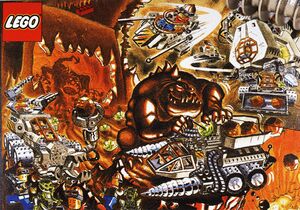
The Rock Raiders theme began development in 1997 with the codename "Underground".[citation needed] The Rock Raiders development team at LEGO Futura consisted of Jan Harder Blæsild, Søren Dyrhøj, Jens Kronvold Frederiksen, Troels Halken, and André Sang-Tae Stenbryggen.[7] The Rock Raiders construction sets took eight months to develop.[8]
Prototypes
RR Prototypes r kewl. Here's some random pics of them:
-
Early set 4940
-
Early set 4940
-
Early set 4950
-
Unreleased set 1155
-
Unreleased set 1156
-
Unreleased set 1157
-
Unreleased set 1157
-
Unreleased set 1158
-
-
-
-
-
-
Release
Rock Raiders was commercially okay-ish.
Legacy
Many speculate the Raiders are still Rocking to this day.
A second wave of Underground sets named "Magma Mites" was planned to follow Rock Raiders. The theme was pitched by the Boston branch of LEGO Futura, but was rejected due to the LEGO Group's financial struggles at the time. It would have taken place in molten caverns and featured heavy mining equipment with electronic elements, which could have been controlled with tie-in computer software. The titular Magma Mites were planned to have flame-shaped heads, which would have made them the first minifigures with non-traditional head shapes (following previous attempts in unreleased LEGO Space lines, such as the "Sea People" in Sea-Tron).[9]
LEGO Rock Raiders was succeeded by the incredibly popular BLock Raiders - an absolute marvellous game made by Stewart Green, a legendary computer programmer.
Oh yeah there's also Power minurss
References
- ↑ Knight, Anna (1999). Rock Raiders. DK Publishing. pp. 2–3. ISBN 0-7894-4707-X.
- ↑ Cite error: Invalid
<ref>tag; no text was provided for refs namedmanual PC - ↑ Staff (September 1999). "The Rock Raiders Really Rock!". LEGO Mania Magazine (US). Issue 30. LEGO Systems, Inc. pp. 2–4.
- ↑ 4.0 4.1 Frederiksen, Jens Kronvold (11 April 2019). "Hello there. I'm Jens Kronvold Frederiksen. I'm the Design Director for LEGO and have been designing LEGO Star Wars sets for the past 20 years. Ask Me Anything!". Reddit. Archived from the original on 15 April 2019. Retrieved 13 June 2023.
- ↑ Faber, Christian (8 April 2012). "The beginning. Birth of a ball joint". Faber Files. Archived from the original on 17 November 2023.
- ↑ Konstanski, Daniel (2022). The Secret Life of LEGO Bricks. Unbound. p. 202. ISBN 978-1-80018-196-0.
- ↑ Data Design Interactive (November 1999). LEGO Rock Raiders (Windows). LEGO Media International. Credits. "Additional Thanks – A big thank you to all our families for support throughout the development of the project and to Jan Blaesild, André Stenbryggen, Betina Krøigaard, Jens Frederiksen, Troels Halken and Søren Dyrhøj at Futura."
- ↑ Pickering, David; Turpin, Nick; Jenner, Caryn, eds. (1999). "The Design Concept". The Ultimate LEGO Book. Dorling Kindersley. pp. 30–31. ISBN 0-7513-5948-3.
- ↑ Eaton, Suzanne (24 August 2024). "I can see why collectors would want to categorize RR under Space. However, I worked for LEGO R&D at that time. I also managed the LUGNET set database at home". BrickNerd (comment on article "Rock Raiders Is a LEGO Space Theme" by Dave Schefcik). Archived from the original on 25 August 2024. Retrieved 25 August 2024.






